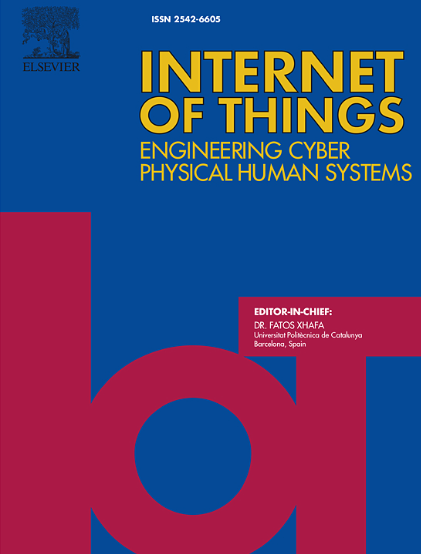An energy-balanced and load-aware routing algorithm based on molecular diffusion theory for energy harvesting assisted WSN
IF 7.6
3区 计算机科学
Q1 COMPUTER SCIENCE, INFORMATION SYSTEMS
引用次数: 0
Abstract
Energy Harvesting-Wireless Sensor Networks (EH-WSNs) play a crucial role in the development of Green Internet of Things (GIoT). While the energy-harvesting process alleviates the constraints of energy supply in WSNs, most current routing protocols for EH-WSNs inadequately account for the heterogeneity in energy states and traffic loads among sensor nodes, which may impair the energy efficiency and transmission performance of networks. To address the above issues, we utilize molecular diffusion theory to design an energy-balanced and load-aware routing algorithm (EBLARA-MD for short) for EH-WSNs. Initially, we construct a dual EH prediction model based on the clustering Markov chain (MC) method, to accurately forecast the amount of solar and wind power generation. Subsequently, an energy-rank model is established to assess the energy levels of nodes. Building on this, we propose a cross-layer adjustment scheme to avoid energy depletion and wastage. Namely, at the Media Access Control (MAC) layer, the backoff time is optimized dynamically to affect the channel access probability of each node; at the physical layer, the transmission power is determined adaptively by considering the wireless fading property. In addition, we construct a load-aware model to reflect the congestion degree of data buffer. Finally, we leverage molecular diffusion theory to allocate the routing probabilities for suitable paths. Simulation results demonstrate that the proposed routing algorithm achieves superior performance in terms of energy efficiency, end-to-end delay variance, and packet delivery ratio.
基于分子扩散理论的能量平衡负载感知路由算法用于能量收集辅助WSN
能量采集-无线传感器网络(EH-WSNs)在绿色物联网(GIoT)的发展中起着至关重要的作用。虽然能量收集过程减轻了传感器网络中能量供应的限制,但目前大多数eh - wsn路由协议没有充分考虑传感器节点之间能量状态和流量负载的异质性,这可能会影响网络的能量效率和传输性能。为了解决上述问题,我们利用分子扩散理论设计了一种用于EH-WSNs的能量平衡和负载感知路由算法(EBLARA-MD)。首先,我们构建了基于聚类马尔可夫链(MC)方法的双EH预测模型,以准确预测太阳能和风能发电量。然后,建立能量等级模型来评估节点的能量等级。在此基础上,我们提出了一种跨层调整方案,以避免能源消耗和浪费。即在媒体访问控制(MAC)层,动态优化退避时间以影响各节点的信道访问概率;在物理层,考虑无线衰落特性自适应确定传输功率。此外,我们还构建了一个负载感知模型来反映数据缓冲区的拥塞程度。最后,我们利用分子扩散理论来分配合适路径的路由概率。仿真结果表明,所提出的路由算法在能量效率、端到端时延方差和分组分发率等方面都取得了较好的性能。
本文章由计算机程序翻译,如有差异,请以英文原文为准。
求助全文
约1分钟内获得全文
求助全文
来源期刊

Internet of Things
Multiple-
CiteScore
3.60
自引率
5.10%
发文量
115
审稿时长
37 days
期刊介绍:
Internet of Things; Engineering Cyber Physical Human Systems is a comprehensive journal encouraging cross collaboration between researchers, engineers and practitioners in the field of IoT & Cyber Physical Human Systems. The journal offers a unique platform to exchange scientific information on the entire breadth of technology, science, and societal applications of the IoT.
The journal will place a high priority on timely publication, and provide a home for high quality.
Furthermore, IOT is interested in publishing topical Special Issues on any aspect of IOT.
 求助内容:
求助内容: 应助结果提醒方式:
应助结果提醒方式:


